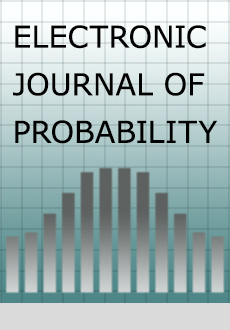Abstract
Consider a Markov process $\omega_t$ at stationarity and some event $\mathcal{C}$ (a subset of the state-space of the process). A natural measure of correlations in the process is the pairwise correlation $\mathbb{P}[\omega_0,\omega_t \in \mathcal{C}] - \mathbb{P}[\omega_0 \in \mathcal{C}]^2$. A second natural measure is the probability of the continual occurrence event $\big\{ \omega_s \in \mathcal{C}, \, \forall \, s \in [0,t] \big\}$. We show that for reversible Markov chains, and any event $\mathcal{C}$, pairwise decorrelation of the event $\mathcal{C}$ implies a decay of the probability of the continual occurrence event $\big\{ \omega_s \in \mathcal{C}\, \forall \, s \in [0,t] \big\}$ as $t \to \infty$. We provide examples showing that our results are often sharp.
Our main applications are to dynamical critical percolation. Let $\mathcal{C}$ be the left-right crossing event of a large box, and let us scale time so that the expected number of changes to $\mathcal{C}$ is order 1 in unit time. We show that the continual connection event has superpolynomial decay. Furthermore, on the infinite lattice without any time scaling, the first exceptional time with an infinite cluster appears with an exponential tail.
Citation
Alan Hammond. Elchanan Mossel. Gábor Pete. "Exit time tails from pairwise decorrelation in hidden Markov chains, with applications to dynamical percolation." Electron. J. Probab. 17 1 - 16, 2012. https://doi.org/10.1214/EJP.v17-2229
Information





